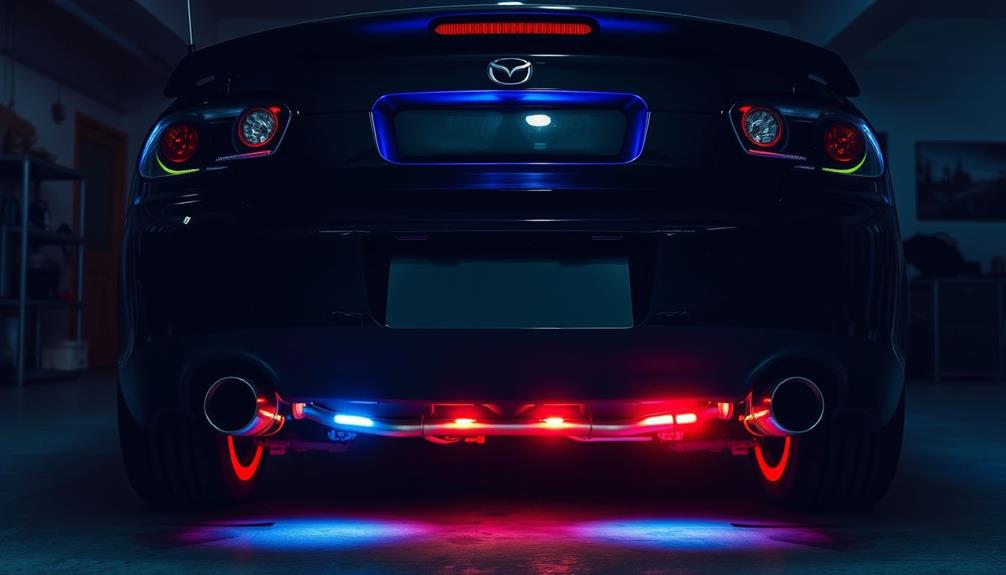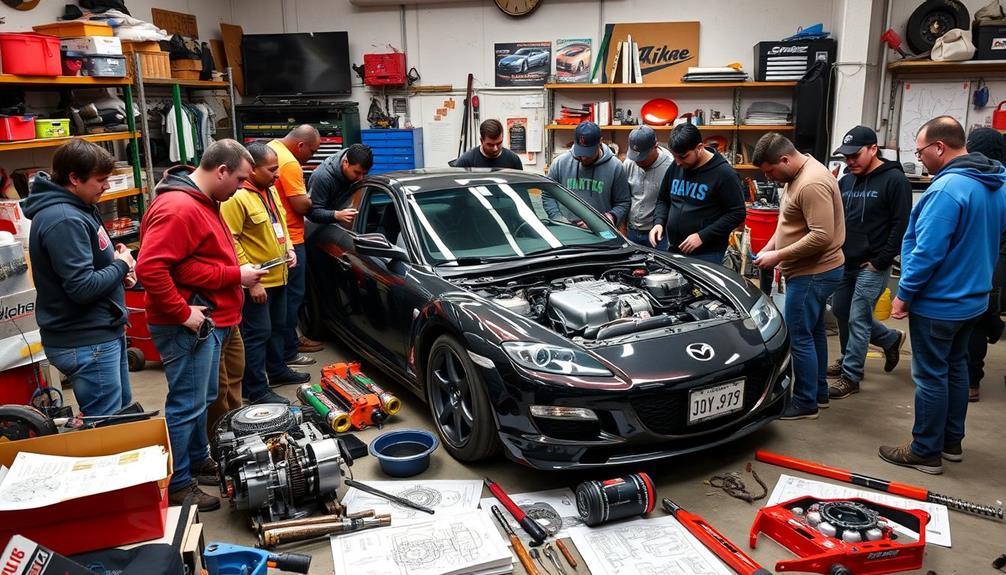Tuning your Mazda RX-8 can truly release its rotary engine's potential, making it a more thrilling sports car. Start by considering upgrades like catback exhaust systems and cold air intakes for improved airflow and sound. If you're after more power, ECU modifications or even forced induction can take performance to the next level. Be mindful, though—while some upgrades may seem tempting, they often come with high costs and varying returns on investment. Careful planning and tracking performance metrics are essential for success. Stick around, and you'll uncover strategies to optimize every aspect of your RX-8 tuning journey.
Key Takeaways
- Upgrade your RX-8 with catback exhausts and cold air intakes for improved sound and airflow, though expect minimal power gains.
- Consider ECU modifications for a modest boost of around 10 hp, with costs between $500 and $800.
- For significant power increases, explore forced induction options like turbocharging, though they require substantial investment and additional modifications.
- Regular maintenance and monitoring of compression, EGTs, and air-fuel ratios are crucial to prevent performance issues and engine damage.
- Use high-octane fuel (93 octane) and consider water/methanol injection for enhanced performance and cooling under high boost conditions.
Understanding Modifications
When you plunge into tuning your Mazda RX-8, understanding modifications is fundamental. The RX-8's rotary engine offers unique characteristics, making it essential to choose the right upgrades.
Start by considering common modifications, like catback exhaust systems and cold air intakes. While these can enhance your car's sound and airflow, they typically provide minimal power gains, so don't expect dramatic results.
Next, think about engine tuning options, such as ECU modifications. These can range from $500 to $800, but you should know that they usually yield limited horsepower increases. Each modification you consider has unique benefits and drawbacks, making it important to conduct thorough research before diving in.
If you're aiming for significant upgrades, forced induction via turbocharging or supercharging might catch your eye. However, be prepared for costs exceeding $5,000 and the need for further modifications to guarantee reliability and performance.
Cost and Performance Analysis

When you consider tuning your RX-8, it's crucial to weigh the costs against the performance gains.
Many modifications, like catback exhausts and ECU tweaks, can be pricey yet offer minimal horsepower increases.
Understanding this balance will help you make informed decisions about where to invest your money for the best results.
Cost of Modifications
Tuning your Mazda RX-8 can quickly become a costly endeavor, especially when considering the return on investment for various modifications. You might find that while some upgrades promise real power, they often come with hefty price tags and limited performance gains.
- Catback exhaust systems: $800 – $1,000 (minimal power increase)
- Cold air intakes: $400 – $600 (variable impact)
- ECU modifications: $500 – $800 (slight power boosts)
- Turbocharging: over $10,000 (requires extensive planning)
- Nitrous systems: temporary boosts with potential risks
These costs reflect the unique challenges of rotary performance tuning. Many RX-8 modifications tend to be pricier than those for more common vehicles, like the Civic.
For example, while a catback exhaust may enhance your car's sound, the negligible power gain might leave you wondering about the cost of modifications.
If you're aiming for a significant upgrade, such as turbocharging, be prepared for a substantial investment along with the need for additional reliability modifications.
Ultimately, the quest for real power in an RX-8 is a balancing act between cost and performance, demanding careful consideration of your goals and budget.
Performance Gains Analysis
Understanding the cost of modifications is only part of the equation; you also need to weigh the performance gains associated with each upgrade. For instance, while a catback exhaust for your RX-8 might set you back $800 to $1,000, the actual power gain is often negligible. This reflects a high cost-to-performance ratio common with RX-8 parts.
Cold air intakes can range from $400 to $600, offering varying power increases based on your specific setup and tuning.
On the other hand, ECU modifications, priced between $500 and $800, typically yield limited gains of around 10 horsepower, emphasizing the importance of careful tuning for peak performance.
If you're looking for major horsepower upgrades, be prepared to invest considerably; a turbocharging setup can easily exceed $10,000 when factoring in necessary modifications and tuning.
Alternatively, nitrous systems can provide temporary power boosts of up to 65 horsepower, but they come with risks that may lead to engine damage.
Series-Specific Modifications

The Mazda RX-8 features distinct series-specific modifications that greatly impact performance and tuning compatibility. Understanding these differences is essential for optimizing your tuning experience.
The Series 1 (2004-2008) and Series 2 (2009-2012) models share many similarities, but variations in engine design, OMP systems, and electronic components can considerably affect your tuning choices.
- Series 2's improved exhaust system can enhance exhaust flow but may require specific adjustments.
- Aftermarket intake systems like Mazdaspeed and AEM provide limited power gains (1-3.6 hp).
- Increased exhaust porting methods can boost power but pose risks for Series 1 engines, particularly concerning exhaust gas temperatures (EGTs).
- Apex seals wear differently between series, impacting durability and performance.
- Carefully adjusting the timing map can maximize engine efficiency and responsiveness.
When planning modifications, it's essential to comprehend the unique tuning requirements and compatible parts for your RX-8 series.
This knowledge helps you avoid performance issues and guarantees you get the most out of your rotary-powered sports car.
Exhaust and Noise Management

Managing exhaust noise in your Mazda RX-8 is vital, especially given its distinctive high-pitched, raspy exhaust note. Effective noise management helps you stay compliant with local regulations while enhancing your driving experience. One option is to take into account a catback exhaust system, which can improve exhaust flow, although the power gains might be minimal.
When modifying your exhaust, it's important to choose the right resonator to help manage sound levels. Here's a quick comparison of popular options:
| Type | Features | Price Range |
|---|---|---|
| BHR Single Resonated | Single chamber for reduced noise | $200 – $300 |
| Agency Power Dual Resonated | Dual chambers for balance | $300 – $400 |
| Racing Beat Dual Resonated | Enhanced sound control | $400 – $600 |
It's essential to remember that removing the catalytic converter can boost exhaust flow but may trigger a check engine light and often violates laws. Always research local noise ordinances and weigh the emissions compliance impacts of your modifications.
Tuning Options for Performance

When it comes to tuning your Mazda RX-8 for enhanced performance, a variety of options are available that can greatly boost your driving experience.
By exploring these tuning options, you can access the potential of your rotary engine and enjoy improved responsiveness and power.
- ECU Modifications: Investing $500 to $800 can yield around 10 additional horsepower.
- COBB AccessPORT & MazdaEdit: These tools grant access to advanced tuning maps for Series 2 RX-8s since 2013.
- Lightweight Flywheels: Although they don't directly increase power, they enhance engine responsiveness markedly.
- Turbocharged Setups: Manage boost levels carefully, starting at 8 psi and tuning up to 14-16 psi for peak performance.
- Air-Fuel Ratio & Ignition Timing: Maintaining proper levels is essential; high AFR can lead to power loss and potential engine damage.
Engine Performance Challenges

Tuning your RX-8 can release impressive performance, but it also comes with its share of challenges. One major issue you'll face is compression loss, often stemming from oil seal failure, especially if you're overboosting. Regular compression tests are essential to guarantee your engine's health, particularly if you're looking at used models.
You'll also need to address high exhaust gas temperatures (EGTs). When you push your RX-8's limits, EGTs can rise dangerously high, risking damage to side seals and springs. Monitoring these temperatures during tuning is imperative. Additionally, if your air-fuel ratio isn't correctly tuned, you might experience bogging and power loss at higher RPMs. This emphasizes the significance of precise tuning tailored to your specific setup.
Here's a quick overview of some common challenges:
| Challenge | Cause | Solution |
|---|---|---|
| Compression Loss | Overboosting | Regular compression tests |
| High EGTs | Excessive boost | EGT monitoring during tuning |
| Poor AFR Levels | Improper tuning | Fine-tune air-fuel ratio |
Navigating these challenges effectively will help you maximize your RX-8's performance.
Fuel and Boost Strategies

When tuning your Mazda RX-8, selecting the right fuel and managing boost levels are essential for maximizing performance.
Using 93 octane fuel helps prevent knocking, especially under boost, while proper boost management keeps your engine safe and efficient.
You'll want to monitor your air-fuel ratios closely to guarantee everything runs smoothly and reliably.
Optimal Fuel Selection
Maximizing your Mazda RX-8's performance relies heavily on ideal fuel selection and boost strategies. To get the most out of your rotary engine, choosing the right fuel and maintaining peak conditions is essential.
Here are some key points to take into account:
- Always use high-octane fuel, like 93 octane, to prevent knocking and improve power.
- Implement a water/methanol injection system for enhanced performance and cooling, especially under high boost.
- Keep a close eye on fuel pressure; fluctuations can lead to inefficient combustion and power loss.
- Regularly inspect for fuel leaks and monitor your fuel system to guarantee everything runs smoothly.
- Follow a premix ratio of 4 oz of oil per 10 gallons of fuel to maintain lubrication and protect your engine's health.
Boost Management Techniques
To get the most out of your Mazda RX-8's performance, effective boost management is fundamental, especially when paired with the right fuel strategies.
Start by using high-octane fuel, like 93 octane, to optimize your rotary engine's performance while managing boost levels. Keep an eye on the air-fuel ratio (AFR); it should ideally sit between 10.5 and 11.1 under boost. This range helps prevent richness and power loss at higher RPMs, enabling you to achieve higher power without risking engine damage.
Incorporating water/methanol injection is another smart move. It can notably control detonation and enhance power delivery when you're using pump gas with elevated boost levels.
Remember, the recommended safe boost limit is around 15 psi for FD engines. Going beyond this can lead to serious engine issues, so consistent monitoring is imperative.
Lastly, keep track of your oil consumption. Consistent oil usage could signal potential problems, making it essential to guarantee proper oil metering.
Monitoring and Sensor Insights
Keeping an eye on your Mazda RX-8's monitoring systems is essential for releasing its full potential and ensuring engine longevity.
With the right sensors and systems in place, you can optimize performance and prevent costly damage.
- Knock Sensor: Monitor detonation levels to avoid engine damage.
- Air-Fuel Ratio (AFR): Keep it above 10.5 to maintain power at high RPMs.
- Engine Management Systems (EMS): Consider aftermarket options for precise knock signal interpretation.
- Oil Thermostat: Replace the factory version with a 165-degree model for better temperature regulation.
- Data Logging: Regularly log boost levels and ignition timing to catch issues early.
Community Resources and Support

The Mazda RX-8 community boasts a vibrant network of resources and support that can greatly enhance your tuning journey. Engaging with fellow enthusiasts through forums like RX-8 Club and Mazda Forum gives you access to nearly 95,000 threads filled with shared experiences, troubleshooting tips, and modification advice. By tapping into the collective wisdom of these knowledgeable individuals, you can gain valuable insights into rotary engine tuning. Additionally, the Mazda RX-8 community is also a great source for finding reputable shops and mechanics who specialize in rotary engine tuning. Many members are happy to share their own experiences and recommend trusted professionals who can help you achieve your tuning goals. Whether you’re looking for basic maintenance advice or more advanced Mazda RX8 tuning tips, the community is ready to offer support and guidance every step of the way.
Participating in community events and meetups is a fantastic way to network and learn firsthand about successful tuning modifications. You'll find that many RX-8 owners are keen to share their experiences and recommendations. For reliable tuning, consider local experts like Japtrix in Riviera Beach, who specialize in rotary engines.
Here's a quick overview of some key community resources:
| Resource Type | Description | Benefits |
|---|---|---|
| Online Forums | RX-8 Club, Mazda Forum | Access to shared knowledge |
| Community Events | Local meetups, car shows | Networking and firsthand learning |
| Expert Recommendations | Local tuning shops like Japtrix | Reliable tuning services |
| Technical Bulletins | Service Bulletins and recalls | guarantees peak RX-8 condition |
| Social Media Groups | Facebook, Instagram RX-8 groups | Real-time support and updates |
Utilizing these resources will certainly enrich your tuning experience.
Frequently Asked Questions
How Much HP Can You Get Out of a Mazda Rx-8?
You can get around 238 horsepower from a stock Mazda RX-8. However, with the right modifications and tuning, you could achieve approximately 350-400 rwhp, greatly enhancing your driving experience and performance.
Can You Tune a Mazda Rx-8?
Yes, you can tune a Mazda RX-8. By using tools like ECU tuning, you'll enhance performance and gain horsepower. Just make certain you monitor adjustments carefully to avoid damaging your engine during the process.
How High Can RX-8 Rev?
Your RX-8 can safely rev up to 9,000 RPM, with peak power around 8,500 RPM. With proper tuning and upgrades, some enthusiasts push it to 10,500 RPM, but careful management is essential to maintain engine health.
What Is the Weakness of the Rx-8?
Every rose has its thorns, and the RX-8's weaknesses include excessive oil consumption, engine reliability issues, and a need for precise tuning. Without proper maintenance, you could face costly repairs sooner than you'd expect.
Conclusion
As you immerse yourself in tuning your Mazda RX-8, remember that each modification isn't just about numbers; it's about forging a deeper connection with your car. Coincidentally, as you push the limits of performance, you might discover more about your own driving style and preferences. Embrace the journey, share your experiences with the community, and let every rev and roar remind you that tuning isn't just an upgrade—it's a celebration of passion and precision. It’s not just about the final result, but the ride you take to get there. As you dive deeper into understanding the nuances of modifying your RX-8, you might even find inspiration from older models, exploring the world of *Mazda RX7 FC performance upgrades* for additional ideas and techniques. Every adjustment and tweak is a reflection of the artistry behind these machines, shaping not just your car, but your experience as a driver.










